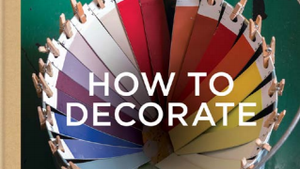Whether looking for books by interior designers or on interior designers, green design or garden design, or something else altogether, Editor at Large has compiled a selection of texts to check out this spring. Nicky Haslam’s A Designer’s Life offers a rare glimpse into the mind and rooms of one of Britain’s greatest talents, while Bunny William’s On Garden Style opens the reader’s mind to new aesthetics balancing practical advice with a sophisticated outcome.
By Interior Designers:
In the introduction to A Designer’s Life (Rizzoli), Nicky Haslam writes: “Personal taste, in all its variations—the eccentric, the grand gesture, the flamboyant, the simple and often downright hilarious—is the grist to my visual mill. It always was, it always will be.” Through his writing, Haslam interrogates this “grist,” the many experiences that have influenced his career, not only as an interior designer but also as an author, artist, singer and even a horse breeder. Available in hardcover, his colorful prose is enhanced by high-gloss photographs of interiors he designed, press cuttings, personal photographs and even some of his own artwork.
In Penny Drue Baird’s Dreamhouse (The Monacelli Press), to be published April 21, Baird takes the reader on a tour of some of the many iconic interiors she has created. From Manhattan and Paris, to family homes in Connecticut and out to Beverly Hills, Baird’s romantic yet contemporary approach to designing is on display around the world. The rich, detailed photographs are accompanied by her narrative, which outlines the process of each project. There's also a foreword by interior designer Mario Buatta.
Windsor Smith shares both her design and life philosophy in her first book, Homefront (Rizzoli), which includes a foreword by Gwyneth Paltrow. Her comfortable yet elegant aesthetic reflects her signature blend of glamour and practicality, a trend favored by her clients in the business and entertainment world. Smith guides readers through their own projects with advice on how to refresh tired rooms and bring balance to a home through design, so that livings spaces can reflect the lives of the people within them in a positive way.
On Interior Design:
Anouska Hempel (Thames & Hudson) by architecture critic and author Marcus Binney takes a close look at the homes, inspirations and life of Anouska Hempel. The renowned designer is known for her creative impetus in all facets of design, from architecture, landscapes and furniture to graphics and fashion. Including an essay by Belinda Harley examining the influences on Hempel’s distinct, opulent yet idiosyncratic aesthetic, the book allows the reader to visit her iconic homes and renowned hotels, as well as many of the interiors she has created over the years.
Entertaining:
Steven Stolman outlines his entertaining how-tos in Confessions of a Serial Entertainer (Gibbs Smith). Filled with menus and anecdotes, novices and seasoned party planners alike will learn how to refine their own entertaining, whether that means gaining confidence or just learning to let go and relax.
Garden Design:
Bunny Williams identifies her Connecticut garden as the “emotional center of her life” one of her “greatest creative efforts.” In her new book On Garden Style (Simon & Schuster), she applies lessons learned in interior design to creating outdoor spaces, giving readers a guide to how to garden with style and sophistication by demonstrating how to conceptualize color, texture and context outdoors as well as indoors.
Green Design:
Robin Wilson’s Clean Design: Wellness for your Lifestyle (Greenleaf Book Group Press) highlights design elements that fit her four principles: sustainable, recyclable, hypoallergenic and nontoxic. Inspired by her own childhood allergies, Wilson outlines an eco-friendly method for creating a healthy home without sacrificing style, and shows readers how to limit and eliminate allergen triggers in every area of a home.
Architecture/Urban Design:
Architect and artist Andrew Geller, “the architect of happiness,” is remembered for his unique, whimsical beach houses, including Pearlroth House, Elizabeth Reese House and the New York Hamptons Leisurama development. In Andrew Geller: Deconstructed (Glitterati Incorporated), Geller's grandson Jake Gorst has compiled two decades of interviews and a treasure trove of personal artifacts, including photographs and henceforth unpublished drawings by Geller.
Though a contemporary of Frank Lloyd Wright and a household name in country house architecture in the 20th century, Howard Van Doren Shaw was largely forgotten after his death in 1926. In Inventing the New American House: Howard Van Doren Shaw, Architecture (The Monacelli Press) Stuart Cohen takes a look at Shaw’s life and his many projects reflecting the theories of the Prairie School. From his Chicago practice, Shaw’s talents were commissioned by the leading industrialists of his time, including newspaper magnate Joseph Medill Patterson, Edward L. Ryerson of Ryerson Steel and printer Reuben H. Donnelley. Shaw also designed houses for the Lake Geneva and Hyde Park neighborhoods, the Lake Forest’s Market Square, and the first American shopping center that accommodated automobiles. His revolutionary methods for reinterpreting historic precedents for modern living influence traditionalists and modernists, and became a design hallmark of the period.
The new, expanded edition of Picturing Wright: An Album from Frank Lloyd Wright’s Photographer (The Monacelli Press) presents Frank Lloyd Wright’s life in photographs and is back in print after 20 years. Photographer Pedro E. Guerrero photographed Wright and his work from 1939, up to three weeks before his death. The candid shots of Wright and his work in process provide a unique, behind-the-scenes look at one of America’s most iconic architects.




























